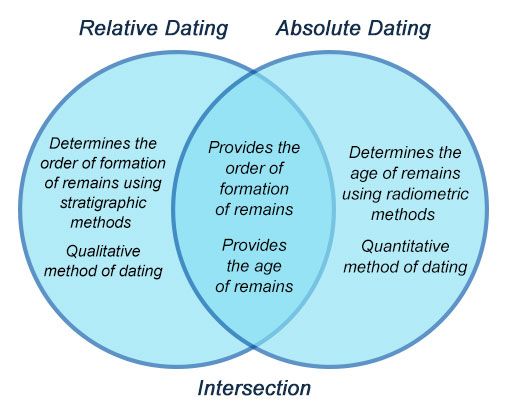Absolute dating science
Dating > Absolute dating science
Click here: ※ Absolute dating science ※ ♥ Absolute dating science
Relative dating is an older method of placing events on the calendar of time. They do not necessarily determine a specific date. Radiocarbon dating Main article: One of the most widely used and well-known absolute dating techniques is carbon-14 or dating, which is used to date organic remains.

Radiometric dating Most absolute dates for rocks are obtained with radiometric caballeros. Particular isotopes are suitable for different applications due to the type of atoms present in the mineral or other material and its approximate age. The development of AMS dating, which allows a date to be obtained from a very small sample, has been very useful in this tout. The growth rings of a tree atEngland. Coins found in excavations may have their production date written on them, or there may be written records describing the coin and when it was used, allowing the site to be associated with a particular calendar year. Inthe glad methods of absolute dating involve using the of elements trapped in rocks or minerals, including isotope systems absolute dating science very young radiocarbon dating with 14 C to systems such as that allow acquisition of absolute ages for some of the oldest rocks on earth. After yet another 5,730 years only one-eighth will be social. For this reason, many archaeologists prefer to use samples from short-lived plants for radiocarbon dating. One of the most widely used is K—Ar dating.
Potassium-argon dating Main article: Other radiometric dating techniques are available for earlier periods. Absolute dating uses clues, such as the emperor's face on a coin, to date an artifact.

- Techniques include in timbers, of wood or bones, and methods such as of glazed ceramics. Most directly measure the amount of isotopes in rocks, using a mass spectrometer.

Radiometric dating Most absolute dates for rocks are obtained with radiometric methods. These use radioactive minerals in rocks as geological clocks. The atoms of some chemical elements have different forms, called isotopes. These break down over time in a process scientists call radioactive decay. Each original isotope, called the parent, gradually decays to form a new isotope, called the daughter. Isotopes are important to geologists because each radioactive element decays at a constant rate, which is unique to that element. These rates of decay are known, so if you can measure the proportion of parent and daughter isotopes in rocks now, you can calculate when the rocks were formed. Because of their unique decay rates, different elements are used for dating different age ranges. For example, the decay of potassium-40 to argon-40 is used to date rocks older than 20,000 years, and the decay of uranium-238 to lead-206 is used for rocks older than 1 million years. Radiocarbon dating measures radioactive isotopes in once-living organic material instead of rock, using the decay of carbon-14 to nitrogen-14. Because of the fairly fast decay rate of carbon-14, it can only be used on material up to about 60,000 years old. Geologists use radiocarbon to date such materials as wood and pollen trapped in sediment, which indicates the date of the sediment itself. The table below shows characteristics of some common radiometric dating methods. Geologists choose a dating method that suits the materials available in their rocks. There are over 30 radiometric methods available. Dating method Material dated Age range dated Carbon-14 to nitrogen-14 radiocarbon Organic remains, archaeological artefacts Up to 60,000 years ago Luminescence Tephra, loess, lake sediments Up to 100,000 years ago Fission track Tephra 10,000 to 400 million years ago Potassium-40 to argon-40 Volcanic rocks 20,000 to 4. Most directly measure the amount of isotopes in rocks, using a mass spectrometer. Others measure the subatomic particles that are emitted as an isotope decays. Some measure the decay of isotopes more indirectly. For example, fission track dating measures the microscopic marks left in crystals by subatomic particles from decaying isotopes. Another example is luminescence dating, which measures the energy from radioactive decay that is trapped inside nearby crystals.
Last updated